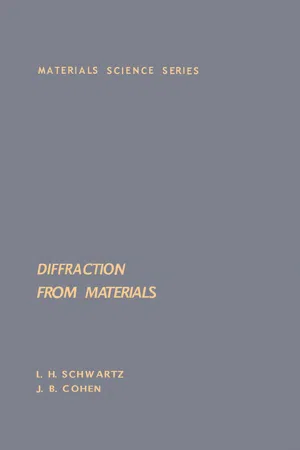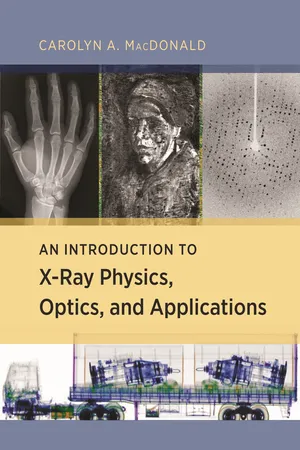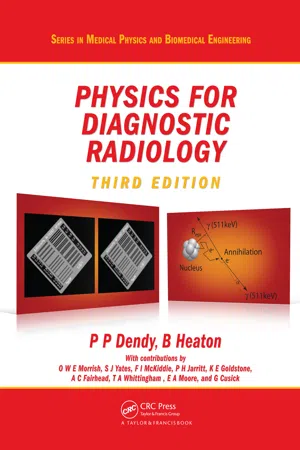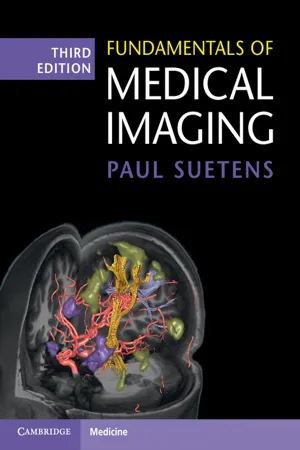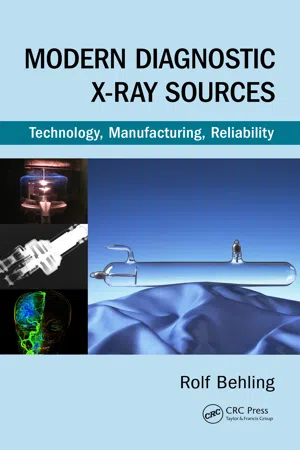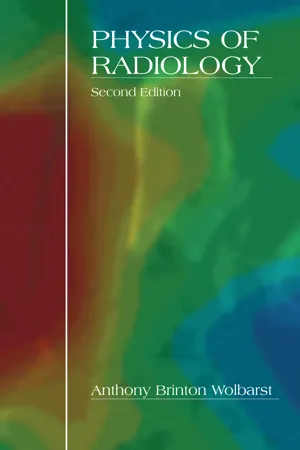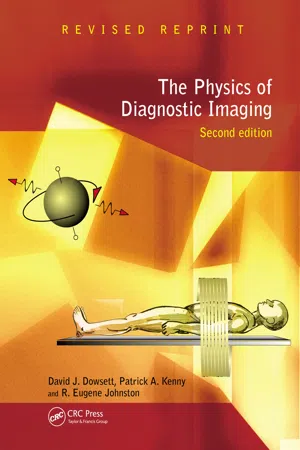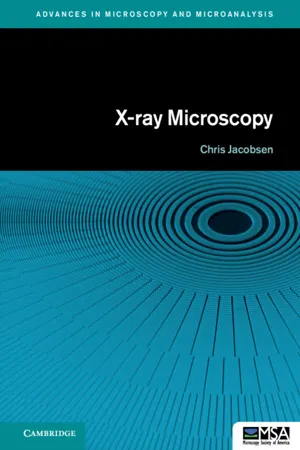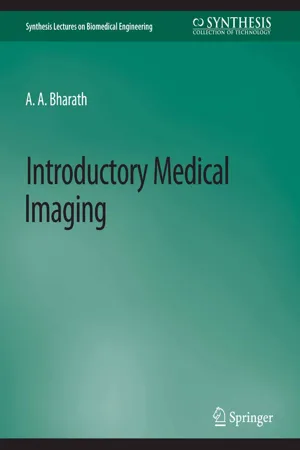Physics
Absorption of X-Rays
Absorption of X-rays refers to the process in which X-ray photons transfer their energy to matter, leading to the removal of the X-ray photons from the beam. This can occur through photoelectric absorption, Compton scattering, or pair production. The likelihood of each type of absorption depends on the energy of the X-rays and the atomic structure of the absorbing material.
Written by Perlego with AI-assistance
Related key terms
1 of 5
10 Key excerpts on "Absorption of X-Rays"
- eBook - PDF
- L.H. Schwartz(Author)
- 2012(Publication Date)
- Academic Press(Publisher)
4.7 THE ABSORPTION OF X RAYS IN MATTER 167 depth to which the beam penetrates and how its intensity varies with depth. We then need to examine the sum total of interactions with material and the resultant effect, absorption. In addition, absorption processes are of consider-able use in their own right. As an x-ray beam passes through a material, radiation is removed from the direct beam by a variety of processes summarized in Fig. 4-29a. We have discussed coherent scattering and Compton (incoherent) scattering in some detail but have not dealt with such processes as photoelectron emission and Auger electron emission. Together with fluorescent x-ray emission, these X-RAY X-RAY PHOTOELECTRON AUGER ELECTRON ABSORPTION EMMISSION EMMISSION EMMISSION (b) FIG. 4-29. (a) Contributions to x-ray absorption. (After Henry, N . F. M., Lipson, H., and Wooster, W. Α., The Interpretation of X-Ray Diffraction Photographs. Macmillan, London, 1951.) (b) Various emission processes which give rise to spectroscopic analytical tools. Energy levels are shown schematically for atoms bound in a solid. (Adapted from Jen-kins, R., An Introduction to X-Ray Spectroscopy. Heyden, N e w York, 1974.) 168 4. PROPERTIES OF RADIATION processes have been used extensively in recent years for chemical analysis and as a means of studying the electron binding energies in solids. A schematic description of these important spectroscopic tools is summarized in Fig. 4-29b. The energies allowed for an electron are represented by several atomic levels including the Κ and L levels plus the valence band. The valence band contains both occupied levels (filled with electrons) and unoccupied levels, separated by the Fermi level. In the x-ray absorption process, quanta of en-ergy hv are absorbed, exciting the electrons to unoccupied levels in the valence band. - Carolyn A. MacDonald(Author)
- 2017(Publication Date)
- Princeton University Press(Publisher)
PART III X-RAY INTERACTIONS WITH MATTER 9 PHOTOELECTRIC ABSORPTION, ABSORPTION SPECTROSCOPY, IMAGING, AND DETECTION 9.1 Absorption coefficients When a beam of light or x rays is incident on a material, pho- tons can be absorbed, causing electrons to be emitted. From the point of view of the electron, this process is called photo- electric emission. From the point of view of the photon, it is termed photoelectric absorption. This knock-out of an elec- tron is the same process discussed in section 4.7 on x-ray fluorescence, although in that case the emphasis was on what happened next if the emitted electron came from a core level. Absorption can be regarded as causing a fluctuation of the electron energy up to a virtual level, as shown in Figure 9-1. For an electron to be emitted, the incoming photon must have an energy greater than the binding energy of the elec- tron, but it is not necessary that the incoming photon energy match a difference in electron energy levels, as is the case for the emitted photon in x-ray fluorescence, il- lustrated in Figure 4-3. The rate at which photons will be absorbed by a single atom is given in terms of a cross section σ ab for absorption, Γ ab,1 = σ ab Ψ , (9-1) where Γ ab,1 is the absorption rate for a single atom, and Ψ is the photon intensity, the number of photons per area per second in the beam. For comparison, the rate Γ at which photons would hit a target of area A placed in the beam is Γ = A Ψ , (9-2) so that the cross section can be seen to have units of area. Cross sections are described in units of barns, where 1 barn = 10 −24 cm 2 . (The unit is a reference to an old saying referring to someone with poor aim as not being able to hit “the broad side of a barn.” A barn is a large cross section in nuclear physics.) FIGURE 9-1. Absorption of a photon can be regarded as the fluctuation of the electron energy up to a “virtual” electron level.- eBook - PDF
- Philip Palin Dendy, Brian Heaton(Authors)
- 2011(Publication Date)
- CRC Press(Publisher)
Both scatter and absorption result in beam attenuation , that is a reduction in the intensity of the collimated beam. If a new term, the mass absorption coefficient µ a / ρ is introduced, it follows that µ a / ρ is always less than the mass attenuation coefficient µ / ρ although the difference is small at low photon energies. From the viewpoint of good radiology, only absorption is desirable since scatter results in uniform irradiation of the image receptor. As shown in Section 6.5, scat-ter reduces contrast on film. It also has an adverse effect in digital imaging systems. Note also that only the absorbed energy contributes to the radiation dose to the patient and µ a / ρ is the most relevant quantity for dosimetry. This is an undesirable but unavoidable side-effect if good radiographic images are to be obtained. 3.4 The Interaction Processes Four processes will be considered. Two of these, the photoelectric effect and the Compton effect are the most important in diagnostic radiology. However, it may be more helpful to discuss the processes in a more logical order, starting with one that is only important at Interaction of X-Rays and Gamma Rays with Matter 81 very low photon energies and ending with the one that dominates at high photon energies. Low photon energies are sometimes referred to as ‘soft’ X-rays, higher photon energies as ‘hard’ X-rays. 3.4.1 Elastic Scattering When X-rays pass close to an atom, they may cause electrons to take up energy of vibra-tion. The process is one of resonance such that the electron vibrates at a frequency cor-responding to that of the X-ray photon. This is an unstable state and the electron quickly re-radiates this energy in all directions and at exactly the same frequency as the incoming photons. The process is one of scatter and attenuation without absorption. The electrons that vibrate in this way must remain bound to their nuclei, thus the pro-cess is favoured when the majority of the electrons behave as bound electrons. - eBook - PDF
- Paul Suetens(Author)
- 2017(Publication Date)
- Cambridge University Press(Publisher)
– The energy of X-ray photons can be absorbed by an atom and immediately released again in the form of a new photon with the same energy but traveling in a different direction. This nonionizing process is called Rayleigh scattering or coherent scattering and occurs mainly at low energies (<30 keV) below the binding energy of the electrons. The lower the energy, the higher is the scattering angle. In most radiological examinations, it does not play a major role because the voltage used is typically in the range from 50 to 120 kV. For mammography, how- ever, the voltage is lower (24–32 kV) and Rayleigh scatter cannot be neglected. – If the photon energy exceeds the binding energy of a tightly bound, inner-shell electron, it can be absorbed and the electron is emitted. This mecha- nism is called photoelectric absorption. – A third phenomenon is that the photon transfers only part of its energy to eject a loosely bound, outer-shell electron. At the same time a new X-ray photon of the remaining lower energy is scattered in a deviating direction, which can even be back- ward. This process is called Compton scattering. – If the energy of a photon is at least 1.02 MeV, the photon can be transformed into an electron and a positron (electron–positron pair). A positron is the antiparticle of an electron, with equal mass but opposite charge. Soon after its formation, how- ever, the positron will meet another electron, and they will annihilate each other while creating two 511 keV photons that fly off in opposite direc- tions. This process, called pair production, finds its application in nuclear medicine. – At still higher energies, photons may cause nuclear reactions. These interactions are not used for med- ical applications. 2.3.2 Interaction of an X-ray Beam with Tissue Consider an X-ray beam and a material of thickness d = x out − x in (see Figure 2.3(a)). Inside the mate- rial, the beam is attenuated by the different types of interactions explained above. - eBook - PDF
Modern Diagnostic X-Ray Sources
Technology, Manufacturing, Reliability
- Rolf Behling(Author)
- 2015(Publication Date)
- CRC Press(Publisher)
81 Chapter 3 The Interaction of X-Rays with Matter Interaction of X-ray photons with human tissue is a great source of information. This imaged flow of contrast agent in cerebral vessels helps to differentiate ischemic from hemorrhagic stroke and direct the therapy. Understanding the fingerprints of X-ray attenuation, scattering, and refraction is essential to gain the most information from the lowest dose of ionizing radiation. The explosion of scientific and clinical work immediately after Conrad Roentgens’ discovery was an indicator for the huge lack of knowledge about the interior mor-phology of patients. “More light” were supposedly Johann Wolfgang von Goethe’s last words. This is what Roentgen has generated. By the same medium, anatomic and functional data are transmitted. The major interactions of X-ray photons with matter will be discussed in the following section to get a glimpse of the informa-tion, which can be expected by measuring them. The Interaction of X-Rays with Matter 82 X-ray photons interact with tissue, fat, bone, water, or air. They are extin-guished or scattered out of the initial direction, or generate secondary photons depending on the elementary composition of the object and the material density. In all these cases, photons disappear from the primary beam. Usually, only a small fraction in the order of a percent will reach the detector. Refraction of X-rays is very small compared to visible light for photons of the relevant ener-gies. Differentiation between direct radiation, which originates in the focal spot, and indirect radiation, which originates elsewhere, is therefore the key for the interpretation of the spatial pattern of X-ray flux sensed by the detector. Another potential source of information, refraction and phase shift of X-rays, has not yet been established on a day-to-day clinical basis, although X-ray phase shifts are comparatively large. - eBook - PDF
- Anthony Wolbarst(Author)
- 2005(Publication Date)
- Medical Physics Publishing(Publisher)
The less material there is in the path of any part of the beam, the greater the amount of x-ray energy that passes through the patient to expose the corresponding part of the film, and the more opaque it is after development. Where the body absorbs or scatters the beam more, conversely, the developed film’s optical density is less; that is, it ends up more transparent. Standard radiographic imaging may be thought of as involving four separate processes (Figure 3–1): • Generation of a nearly uniform beam of penetrating x-rays. These emanate from a point on the anode of the x-ray tube and travel along straight paths that, by the time they reach the patient, are nearly parallel • Differential attenuation of the beam by the tissues and organs being imaged. Various bones and soft tissues of the patient’s body absorb and scatter different amounts of the x-ray energy, thereby imprinting an x-ray shadow image onto the previously uniform beam • Detection of the radiation exiting the body by a film held within a cassette. Patterns of remnant, unabsorbed x- rays emerging from the body expose a radiographic cassette containing a sheet of special photographic film, leading to the formation of a visual image after the film is developed. The more radiation that reaches any part of the cassette, the darker the corresponding portion of film becomes. In a chest film, for example, a rib lets through relatively little x-ray energy, and thus shows up as a pale band against the dark, opaque surrounding areas of the film that correspond to lung, which are more transparent to x-rays • Analysis and interpretation of the image. This depends on the quality of the final image, the viewing condi- tions and the skills of the physician and, if a comput- er-aided detection (CAD) system is in service, on its level of sophistication. - eBook - PDF
Gaseous Radiation Detectors
Fundamentals and Applications
- Fabio Sauli(Author)
- 2014(Publication Date)
- Cambridge University Press(Publisher)
In this chapter, the absorption and photoelectric processes are discussed in detail, while the processes occurring at higher energies (Compton scattering, pair production) are only briefly mentioned. Equally important for understanding the gas counters operation are the pro- cesses of photon emission in gas discharges, followed by absorption in the gas itself or on the counter’s electrodes, often resulting in the emission of secondary electrons or photons; this subject is covered in Chapter 5. 43 3.2 Photon absorption: definitions and units The absorption of a mono-energetic beam of photons by a uniform layer of material of thickness x is described by an exponential law: I ¼ I 0 e μρx ¼ I 0 e αx , ð3:1Þ where I 0 , I are the photon fluxes entering and leaving the layer, μ the mass absorption coefficient (in cm 2 /g), ρ the density of the material (g /cm 3 ) and x is in cm; α ¼ μρ (in cm 1 ) is the linear absorption coefficient, and represents the probability of interaction per unit length of absorber; its inverse, λ ¼ α 1 , is the absorption length. Introducing in the expression the reduced material thickness χ ¼ ρx (in g/cm 2 ): I ¼ I 0 e μχ : ð3:2Þ The fraction of photons removed from the beam (the theoretical detection effi- ciency, if all interactions result in a visible signal) is then: ε ¼ I 0 I I 0 ¼ 1 e μχ : ð3:3Þ The linear absorption coefficient relates to the absorption cross section (in cm 2 ) through the expression: α ¼ N σ, ð3:4Þ where N is the number of atoms or molecules per unit volume: N ¼ N A ρ=A: ð3:5Þ In the expression, N A ¼ 6.0247 10 23 molecules/g mole is the Avogadro number and A the atomic weight (in g/mole). - eBook - PDF
- David Dowsett, Patrick A Kenny, R Eugene Johnston(Authors)
- 2006(Publication Date)
- CRC Press(Publisher)
L-shell electrons also show absorption edges as seen in Fig. 5.13. The element tin, on a weight for weight basis, is a better absorber between the ener-gies 29 to 88 keV despite having a lower atomic num-ber (for Sn, Z 34; for Pb, Z 88). This would suggest that tin is a better shielding material than lead at diagnostic energies, but cost must be taken into consideration. Important elements whose K edges appear within the diagnostic energy range are: • X-ray filters (e.g. molybdenum, rhodium, erbium) • Intensifying screen materials (e.g. tungsten, gadolinium) E E E A bK bL 2 Interactions with the atom 125 10 10 5 10 4 10 3 10 2 100 Photon energy (keV) 1000 L Edges K Edge Attenuation coefficient m (m 1 ) Figure 5.12 Relative energies of the absorption edges and characteristic emission lines of lead. • Scintillation detectors (iodine, cesium) • Contrast enhancing agents (barium, iodine) 5.4.2 Radiation scattering The general picture of attenuation in Fig. 5.1 shows another process as well as absorption which can be responsible for preventing photons from reaching a target area (image receptor plane such as film). This is photon scattering and mostly involves electrons in the outer orbits. The scattered photon can assume any angle from 0° to 180°. COHERENT OR ELASTIC SCATTERING When an X-ray or gamma photon is incident on an atom then scattering can take place either: • From the bound electrons (Rayleigh scattering:) providing that the electrons do not receive suffi-cient energy to eject them from the atom • From free or loosely bound electrons (Thomson scattering) They are both examples of coherent or elastic scatter-ing, in which the incident photon undergoes a change in direction without a change in energy. This is the only type of interaction between X-rays and matter in which no energy is transferred and no ionization of the target atom occurs. - eBook - PDF
- Chris Jacobsen(Author)
- 2019(Publication Date)
- Cambridge University Press(Publisher)
3.3 The x-ray refractive index 45 it would be wrong to conclude that elastic scattering is unimportant in soft x-ray optical systems. If the amplitudes scattered by the atoms in a unit of matter are added coher- ently, the total scattered intensity scales with the square of the volume of the unit while the total absorbed intensity scales linearly with volume. Therefore, as the unit becomes larger, scattering is increasingly favored over absorption so long as the superposition continues to be coherent. This property is exploited in gratings and zone plates, and is considered further below. (Similar coherence arguments apply to other radiation, such as electrons, neutrons, or hard X rays, though the angular extent of the enhancement scales as the wavelength and is restricted to small angles in electron microscopy, for example). We will see in Section 3.3.3 that the linear absorption coefficient (LAC) [J¨ onsson 1928] for x-ray propagation in media can be written as μ = 2λr e n a f 2 = n a σ abs , (3.45) which is consistent with Eq. 3.43 because, for uniform matter, the elastically scattered amplitudes add to zero in all directions except the forward. For observable scattering to take place there must therefore be some degree of nonuniformity – and a specimen without nonuniformity is a pretty boring specimen for x-ray microscopy! The consequence of photoelectric absorption is the generation of Auger and photo- electrons (along with x-ray fluorescence photons). These energetic electrons then un- dergo inelastic scattering to produce a cascade of lower-energy electrons, and the typi- cal range of this electron shower as a function of the primary electron energy is shown in Fig. 3.12 (the inelastic mean free paths of low-energy electrons in several materi- als are shown in Fig. 6.9). Remember that chemical bonds have energies of only a few eV (Box 3.2), so one primary x-ray absorption event can lead to many electrons that damage many chemical bonds. - eBook - PDF
- Anil Bharath(Author)
- 2022(Publication Date)
- Springer(Publisher)
• It must be usable to describe both large and small dosage quantities. • It must be usable at all radiation energies (in a practical sense). • It must be easily related to tissue absorbed dose (see later). Ionisation in air is an extremely sensitive measure; if a 100keV photon is completely absorbed in a region of air, the ionisation results in very many ion pairs. Furthermore, in terms of biological damage, ionisation is the most relevant effect of radiation. This measure focuses primarily on the ionisation capability of the beam, and is therefore the measure though to be most appropriate for patient safety considerations. The measurement of this property of an x-ray beam can be performed by using ionising chambers or the GM (Geiger-Muller) tube. Of these, the GM tube is more sensitive, compact and lighter, and can detect lower energies of radiation; however, it does not have a very direct relationship with the measure of exposure defined above, and this can limit its relevance (and use) in diagnostic radiation monitoring. Other types of radiation detectors and monitors are covered elsewhere in the MSc course. 30 CHAPTER 2. DIAGNOSTIC X-RAY IMAGING 2.8.2 ABSORBED DOSE Dose is a measure of actual energy absorbed by an object from the x-ray beam. It is measured in units of energy per mass, such as J kg −1 . Dose is related to the amount of ionisation in biological tissue. Actual biological damage is, of course, very hard to define, since any assessment of damage must consider the biological function of the tissue, and how that function is affected by radiation. It is known that some cells, due to their biomolecular structure, are quite radiation resistant, while others are radiation sensitive. The absorbed dose, D, is defined by D = E m (2.41) where E is the mean energy imparted by ionizing radiation to a sample of matter of mass m. The current unit of absorbed dose is the Gray, which is equal to 1 J kg −1 , and is also equivalent to 100 rad, the old unit of dose.
Index pages curate the most relevant extracts from our library of academic textbooks. They’ve been created using an in-house natural language model (NLM), each adding context and meaning to key research topics.
